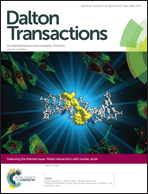One-dimensional lanthanide coordination polymers: synthesis, structures, and single-ion magnetic behaviour†
Abstract
A family of isostructural one-dimensional (1D) lanthanide compounds with the formula [LnIII(L)(NO3)(DMF)2]∞, where Ln = Tb (1), Dy (2), Ho (3) and Er (4), was synthesised and structurally characterised. The magnetic behaviour of these compounds is demonstrated, and their static and dynamic properties are discussed and analyzed. The results of dc magnetic susceptibility measurements regarding compounds 1–4 indicate the existence of thermal depopulation of the crystal field-induced splitting of mJ levels of Ln ions, while the observed frequency-dependent out-of-phase ac magnetic susceptibility signals under certain magnetic fields for compounds 1, 2, and 4 show a slow relaxation of the magnetisation with an energy barrier of 6.15, 54.45, and 28.14 K, respectively. Also, complex 2 shows peak maxima of χM′′ signals in temperature-dependent as well as frequency-dependent ac magnetic susceptibility measurements under an appropriate magnetic field, indicating that the relaxation process is dominantly thermally activated.


 Please wait while we load your content...
Please wait while we load your content...